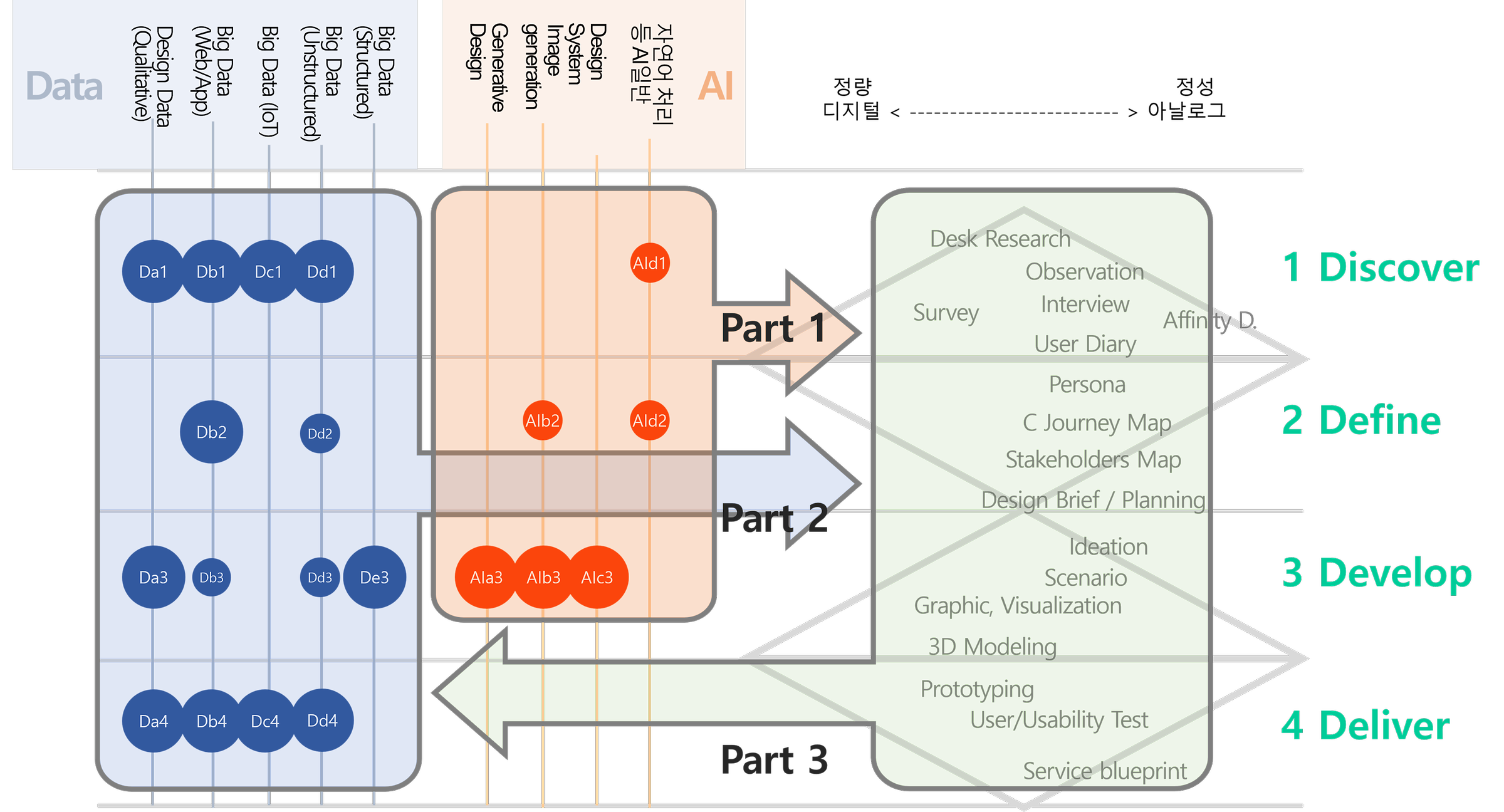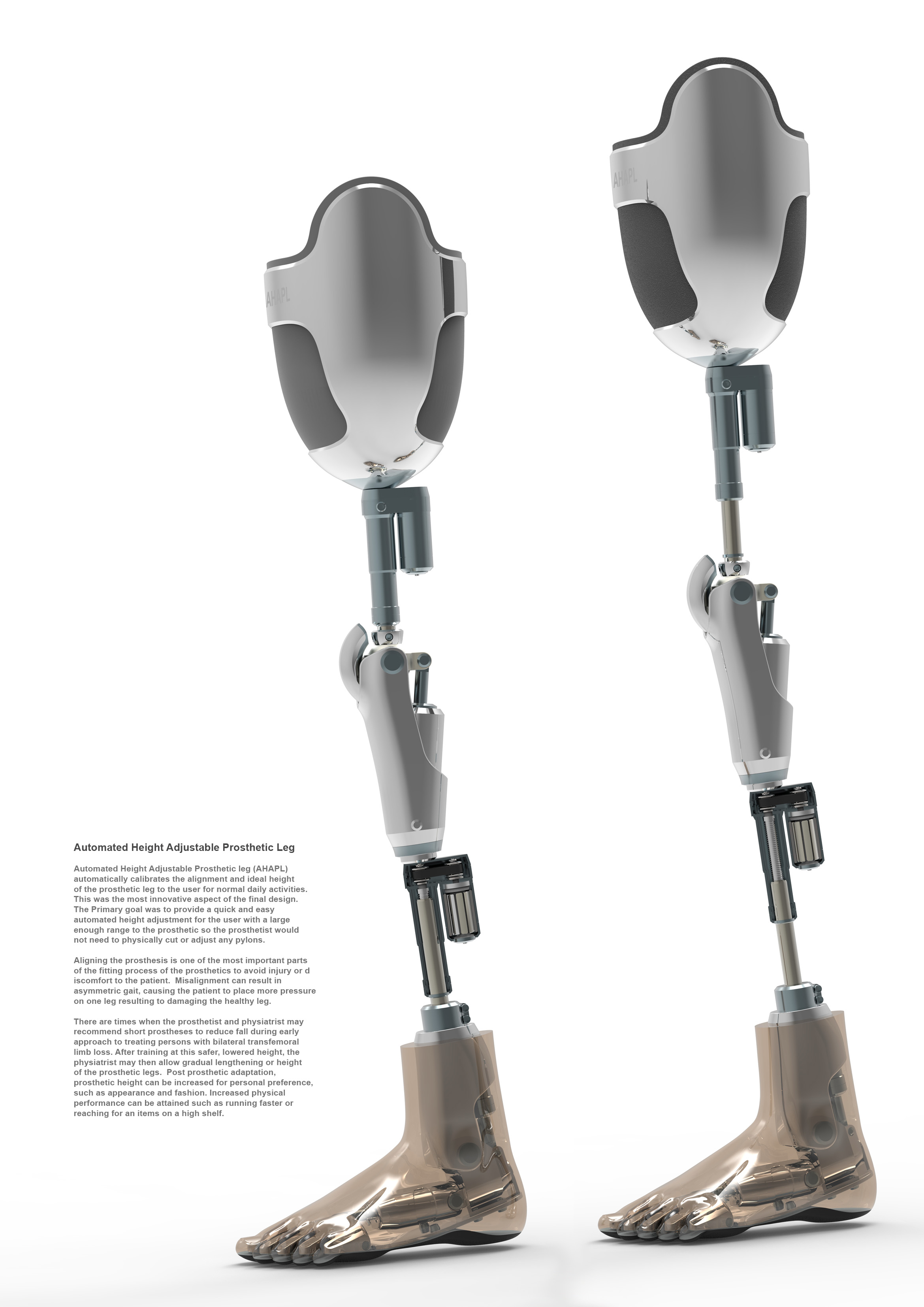- HOME
- Research
- Research Area
Research Area
  |
Proposing Design Process and Methods based on Data and AI Research Support: National Research Foundation of Korea Project Name/Duration: General Collaborative Research / 2023.6 ~2026.5 (3 years) Investigator(s)/Collaborator(s): Myung-Heum Yeon (Kookmin University), Ji-Hyun Lee (Seoul Women's University), Chung-Cheol Jung (Seoul National University) Research Purpose and Content: Today, the role of artificial intelligence in the design field has increased significantly, and expectations and anxieties coexist. One of the reasons for this change is the role of data. The sophisticated analysis of big data and its use in the design process is becoming a new design activity, and AI is also being used for data-driven design. However, there is still a lack of integrated research on the types of data and AI tools, what role they are playing, and at what stage of the design process they are being utilized. In this study, we explore the application of big data, other types of data, and tools and methods based on various AI technologies, such as deep learning, to design work. It analyzes how design processes and methods need to change and how this will affect the skills and qualities required by designers. This research is organized into three parts, as follows: Part 1: Designing with AI Tools: RQ: What are AI design tools, what are the effects of their utilization, and what is the role of designers? Part 2: Data-Driven Design Process Research RQ: How can user log data be utilized to improve online services? Can data compensate for the limitations of qualitative design methods? And what is the desirable integration of big data and qualitative data?
Part 3: Data-based Lean UX Cycle Research RQ: What are the data visualization methods that allow users to reflect on their usage behavior, and how can design questions and prompts be structured through visualization? (prompts) through visualization to create an iterative UX cycle that quickly generates reflective UX prototypes.
Keywords: data-based design, AI-powered design, Design process, UX Design, Online Service |
|
|
Innovative Product Design and Manufacturing
Publication 박지훈, 남원석, 장중식. (2019). STEAM education cases study analysis using Open Source : Focusing on the use of the Knitting Machine. 한국융합학회. 10(12). pp 199~204 조재윤, 남원석, 장중식. (2020). A Study on the Ease of Use of Open Source-based Knitting Machine User Interface Design. 한국융합학회. 11(3). pp 187~194 박지훈, 남원석, 장중식. (2020). Old building green remodeling design cases study analysis using solar cell. 한국융합학회. 11(9). pp 155~162 박지훈, 남원석, 장중식. (2020). Open Source Based Knitting Machine Pattern Program Interface Usability Study. 한국융합학회. 11(4). pp 109~118 |
|
|
Interaction Design for AI Agent in IoT Smart Home
Publication 박주연, 연명흠. (2020). Suitable for Smart Home users' situations Explore the design of a multi-modal interface. 커뮤니케이션디자인학연구 73. pp 431~441 박승태, 연명흠. (2020). Finding Conflicts and Interaction Issues between Smart-Home Multi-Users According to Household Type. 디자인융복합학회 19(6). pp 145~160 오원준, 연명흠. (2019). Finding Issues of Multi-user Interaction at Smart-Home and Design Solutions of the issues -Focused on Control Authority. Journal of Integrated Design Research 18(3). pp 77~90 |
|
|
Design for 3D Printing and Additive Manufacturing
In the field of technology that is developed in connection with 3D printing around the world, various parts such as open source-based electronic and electrical technologies, firmware programming, mechanism design, etc. are being fused and studied, and products with new functions are derived based on this. In Korea, only the narrow functions of 3D printers operated by prototype production, etc. are emphasized and recognized. Accordingly, the open source technology of 3D printing is studied, and the design concept of the new product from the perspective of the designer, the production of prototypes, and the production of prototypes will seek new competitiveness of the designer. In relation to the research and development of clothing 3D printers, wire bending machines, 3D 3D printers, 3D printers, etc. design and application research will be conducted. Publication 정도성, 김관배, 장중식. (2019). A Study on the Change of Designer Environment by 3D Printer Development ; Focused on Hybrid Mechanism and Innovation Product Design. 한국인더스트리얼디자인학회. 13(3). pp 30~39 정우진, 손석우, 장중식. (2020). A Study on The Development of FDM 3D Printer Remote Control Mobile App Usability Evaluation Checklist. 한국인더스트리얼디자인학회. 14(3). pp 1~12 장중식. (2019). A Study on the Design of a Three-Dimensional Printer Smarthead with a Build Accuracy of 20 Micron for Product Design. 한국인더스트리얼디자인학회. 13(1). pp 69~81 Junsik Jang, Keejeung Hong. (2020). Development of a Large 3D printer for Manufacturing Form-Liner and Protective Skin of Concrete Structures. International Journal of Internet, Broadcasting and Communication. 12(3). pp 74~86 |
|
|
Design for Health Care Service and Medical Devices
Publication 노연지, 남원석. (2020). Design for Anxiety Reduction during Magnetic Resonance Imaging : Based on Pattern-Recognition Theory. 한국리서치학회. 5(4). pp 238~250 남원석, 이재원, 정도성. (2017). A Study on Automated External Defibrillator(AED) Design Based on User Observation Method. 산업디자인학연구. 9(1). pp 105~116 |
|
|
Human Experience Design
We explore the design implications of digital technology in our everyday life by observing a wide range of human experiences. We focus on conducting empirical studies to collect and analyze real-world data that will lead to propose novel user experiences in the use of new media. In so doing, we aim to establish an open innovation platform and apply human-centred design approach in the design space of smart living, working and social life. Publication Andy Crabtree, Lewis Hyland, James Colley, Martin Flintham, Joel E Fischer, and Hyosun Kwon. 2019. Probing IoT-based consumer services: ‘insights’ from the connected shower. Personal and Ubiquitous Computing. https://doi.org/10.1007/s00779-019-01303-3 Hyosun Kwon, Joel E. Fischer, Martin Flintham, and James Colley. 2018. The Connected Shower: Studying Intimate Data in Everyday Life. Proc. ACM Interact. Mob. Wearable Ubiquitous Technol. 2, 4, Article 176 (December 2018), 22 pages. DOI: https://doi.org/10.1145/3287054 |
|
|
Sustainable Design
Publication Wolfs, E. L. M. (2015). Biophilic Design and Bio-Collaboration: Applications and Implications in the Field of Industrial Design. Archives of Design Research, 28(1), pp 71-89. A qualitative study of the advantages and limitations of integrating downstream Upcycling activities in the undergraduate Industrial Design Curriculum Wolfs, E. L. (2018). Beyond good intentions: questioning the values in upcycling. 한국디자인학회 학술발표대회 논문집, 32-33. Wolfs, E. L. (2014). Techno-Biophilia: monitoring, management, enhancement, and care of urban ecosystem services with the help of technology. 한국디자인학회 학술발표대회 논문집, 4-5. |
|
|
Design Methods and Design Thinking
Publication 이은솔, 연명흠. (2017). Suggestion on Modified Models of Service Blueprint for Product-Service System. 디자인융복합연구 16(3). pp 69~84 최영채, 연명흠. (2017). A Study of Negative Interaction Between Customers for Proposing `Evil Persona`. 디자인융복합연구 16(2). pp 223~238 황가영, 연명흠. (2017). A Study on the Classification of Role-playing as a Design Method and Its Utilization. 디자인융복합연구 16(3). pp 51~68 천수경, 연명흠. (2017). Suggestion on Format of Stakeholder Map for Product-Service System According to Business Classification. 디자인융복합연구 16(5). pp 253~269 |
|
|
Universal Design and Inclusive Design
Publication Emmanuel, L. M. (2015). Ageist Biases: Identifying and addressing design students’ prejudices towards the silver generation. 한국디자인학회 학술발표대회 논문집, 18-19. |
|
|
Designing with A.I.
Publication 연명흠, 정의태. 2019. Potentiality of AI-Powered Design Tool in Identity Design. 한국디자인학회. 2019 한국디자인학회 가을 국제학술대회 논문집. pp 58~59 |
|
|
Design for Augmented Digital Gifting
Gift exchange is a ritual practice imbued with current values of social relationships. Thus, rituals of gift exchange differ from one place to another or one generation to the other. While the Internet and smart devices have transformed the form of gift and the manner of exchange by enabling dynamic online gifting, the design of digital gifting interfaces are still confined to Mauss’ dyadic exchange protocol – give, receive, and reciprocate. Therefore, in this research, we explore the 'experience' aspect of gift exchange by physically or spatially augmenting intangible digital gifts to enhance the overall exchange experience. Publication Boriana Koleva, Jocelyn Spence, Steve Benford, Hyosun Kwon, Holger Schnädelbach, Emily Thorn, William Preston, Adrian Hazzard, Chris Greenhalgh, Matt Adams, Ju Row Farr, and Nick Tandavanitj. Designing Hybrid Gifts. 2020. ACM Trans. Comput.-Hum. Interact. (TOCHI). 27, 5, Article 37 (October 2020), 33 pages. DOI: https://doi.org/10.1145/3398193 Hyosun Kwon, Holger Schnädelbach, Boriana Koleva, Steve Benford, Tom Schofield, Guy Schofield, Maho Oki, Koji Tsukada, Daniel Harrison, Richard Banks, Tim Regan, and Martin Grayson. 2017. Demo hour. Interactions 24, 5 (August 2017), 8-11. DOI: https://doi.org/10.1145/3125631 Hyosun Kwon, Boriana Koleva, Holger Schnädelbach, and Steve Benford. “It’s Not Yet a Gift: Understanding Digital Gifting”, ACM. CSCW ’17, February 25-March 01, 2017, Portland, OR, USA. DOI: https://doi.org/10.1145/2998181.2998225 |
 |
Human Factors and Design
Publication Wolfs, E. L. (2017). Developing Rewarding, Safe and Sustainable IoT Product Experiences: Challenges and Opportunities for Industrial Design Students. Archives of Design Research, 30(1), 73-85. |










